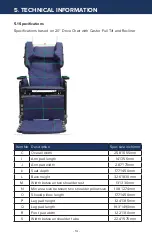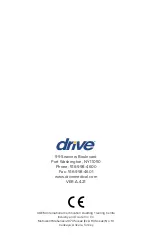
- 7 -
2. SAFETY REQUIREMENTS
2.6 Improper Use
A
s outlined, the improper use of the chair is dangerous to the resident,
caregivers, or third parties, and can consist of, but is not limited to the
following:
2.6.1 Improper Restraint Use - “Risk of Serious Injury”
W
e recommend alternatives to physical restraints be used with residents
while seated in the chair except under the specific instructions of the
resident’s primary caregiver and with permission of the resident’s family
or guardian. Physical restraints have been identified as a common cause
of serious injury to residents while they are seated. We recommend the
primary caregiver responsible for seating first consider the re-positioning
options available in the chair to reduce the risks of sliding, falling, or self-
injury.
I
f a physical restraint is determined to be appropriate to prevent sliding or
falling out of the chair, we recommend a thigh belt be used. In all cases, it is
the resident’s primary caregiver who must take responsibility for the safety
of the resident if restraints are used.
You should NOT have;
1.
Unauthorized operation of the chair’s functions.
2. Unauthorized movement of the chair.
3. Inappropriate use of the chair for a resident who has not been assessed
by a qualified caregiver responsible for their seating.
4. Failure to frequently reposition the resident in the chair
5 Attempting to operate of multiple chair functions simultaneously by one
or more caregivers.
6. Attempting to move the chair with the brake(s) applied.
7. Leaving the resident unattended in the chair near other objects.
8. Leaving an agitated resident in the chair in an unsupervised area.
9. Leaving a resident unattended.
10. Leaving a resident in a chair on a sloping surface.
11. Leaving a chair unattended on a sloping surface.
12. Using non-DRIVE accessories on the chair.
13. Using the chair at temperatures below 0ºC.
14. Using the chair as a shower or bathing chair.
15. Using the chair for any use other than its intended purpose.






































